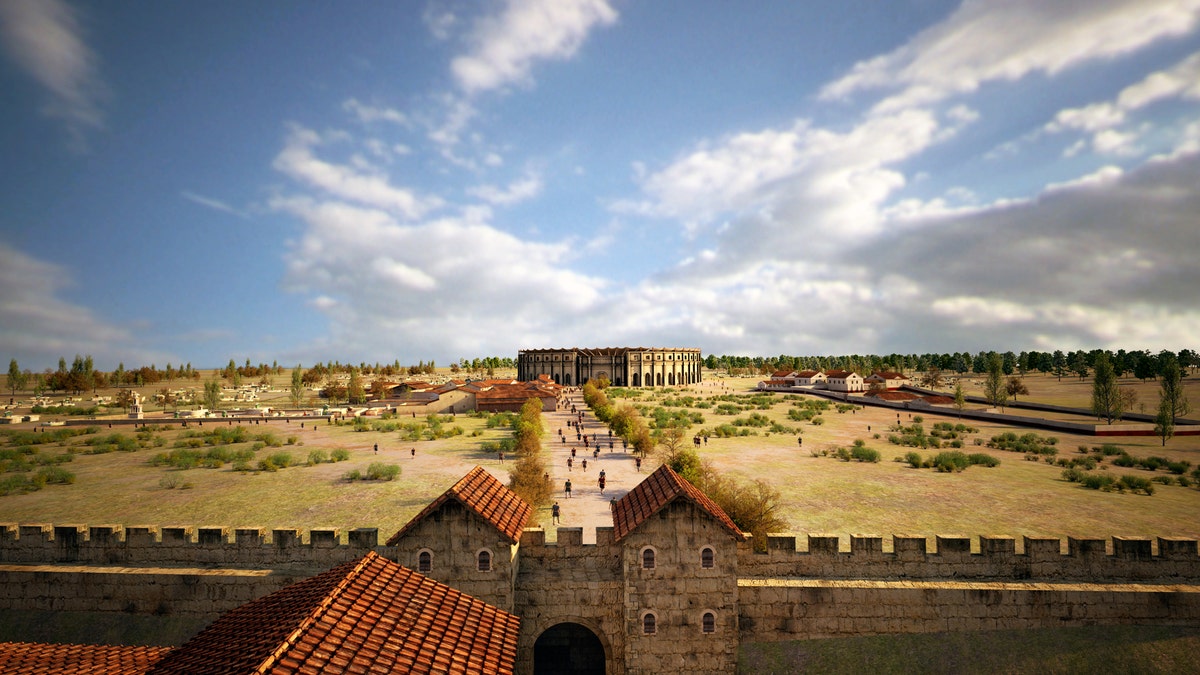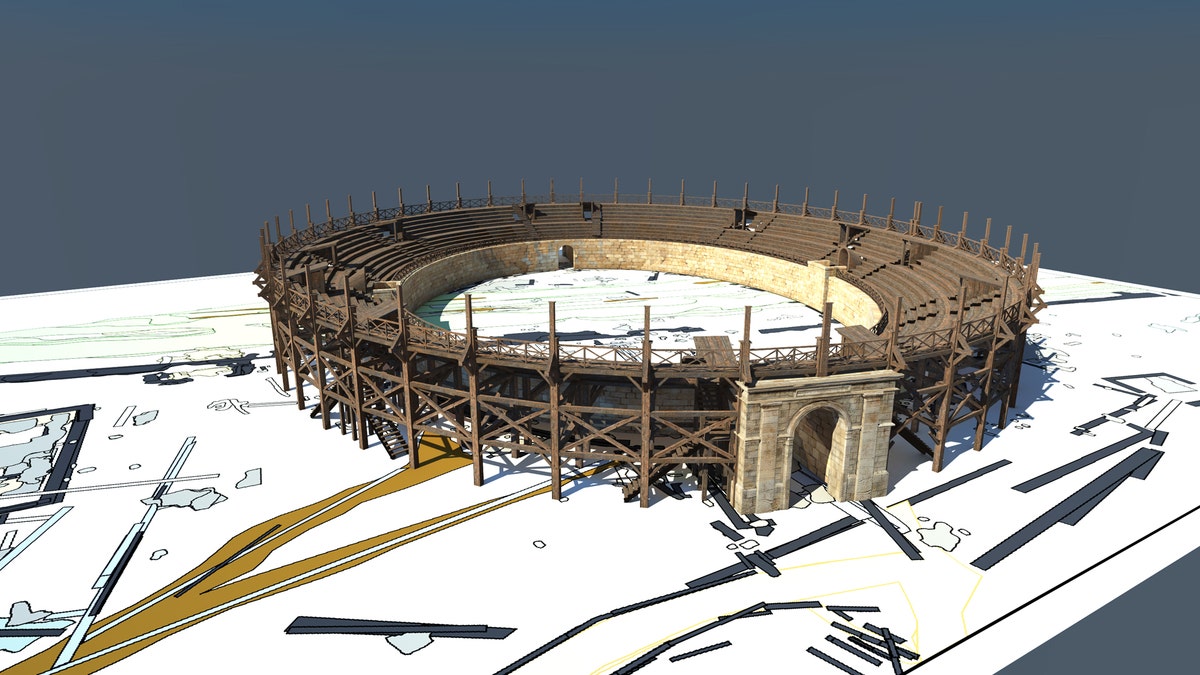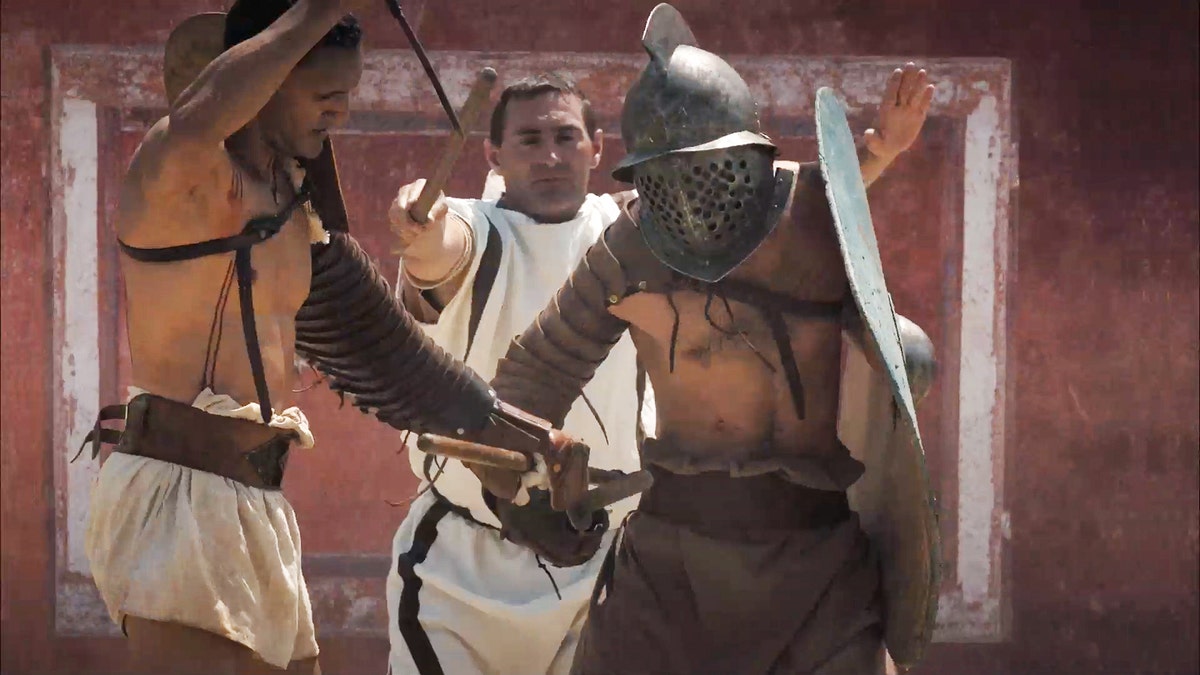
A visualization of Carnuntum's taverns, amphitheater and gladiator school (LBI ArchPro, 7reasons).
Archaeologists in Austria have deployed magnetometers and ground-penetrating radar to discover the concession stands and shops that supported an ancient city’s gladiator games.
Experts from the Ludwig Boltzmann Institute for Archaeological Prospection and Virtual Technology and ZAMG (The Austrian Central Institute for Meteorology and Geodynamics), who discovered a gladiator school at the site in 2011, have made a fascinating series of discoveries around Carnuntum’s excavated amphitheater.
Scans, for example, reveal the incredible infrastructure supporting the town’s gladiator games, which have been buried in the earth for thousands of years.
“The route to the spectacles led the people through the city gates past taverns (tabernae), souvenir shops and food vendors (thermopolia), where street merchants offered their goods for sale and invited the public to linger,” explained the Ludwig Boltzmann Institute, in a statement. Behind one of the taverns, researchers identified a storage building, known as an horreum, and a large oven, where bread was baked for up to 13,000 spectators. Wine and other foodstuffs were stored in underground cellars, according to the archaeologists.
SEARCH IS ON FOR CALIGULA'S 2,000-YEAR-OLD ORGY BOAT

Newly discovered wooden amphitheater – visualization based on geophysical data interpretation (LBI ArchPro, 7reasons).
“It’s an interesting spotlight, because these are things that have never been found before,” Prof. Wolfgang Neubauer, director of the Ludwig Boltzmann Institute, told Fox News. “We can see what these buildings looked like.”
Something of a Mystery
While the stone amphitheater was excavated during the 1920s and 1930s, the surrounding area has remained something of a mystery, with much of the city’s remains buried.
The latest discoveries, which were announced last week, are the result of an exhaustive high-tech survey of the site between 2012 and 2015. Experts scanned 3.3 square miles with ground penetrating radar that measured 1.6-inch x 3.2-inch x 0.8-inch “boxes” in the earth to a depth of 9.8 feet.

Footage of gladiatorial games at Carnuntum (LBI ArchPro, 7reasons).
MAN WHO LIVED 700 YEARS AGO GETS BRAND-NEW FACE
“It’s a really huge amount of big data and a really huge amount of detail,” explained Neubauer, noting that the area with the gladiator games’ concession stands, stores, taverns and bakery, accounted for nearly 0.4 square miles of the surveyed site.
The area where Carnuntum is located became part of the Roman Empire around 15 A.D. The newly-discovered area of concession stands and stores is thought to date from around 200 A.D., when the stone amphitheater was built.
Neubauer told Fox News that the concept of panem et circenses or “bread and circuses,” was a crucial part of Roman culture, with politicians staging free gladiator games for the populace in an attempt to gain support. “It was very important for people that wanted to be elected,” he said.
JACK THE RIPPER MYSTERY: RESEARCHERS HIT ROADBLOCK
Up to 100 pairs of gladiators would fight in a single day’s games, according to the archaeologist, explaining that depictions of gladiatorial combat in modern culture are often inaccurate. “It was not so much the brutal, bloody, thing that was shown in Hollywood movies … there were very strict rules, once it was clear that one guy was winning, it was up to the people to decide if they die or not,” he said, adding that historical research shows more often than not, gladiators’ lives were spared.
The truth about Gladiators
Neubauer explained that for their masters, highly-trained gladiators were a valuable commodity. “They were expensive,” he said. “Many of them did survive six or seven shows without problems – some survived 40, 60, combats.”
Just over 1,300 feet away from the excavated amphitheater and hidden under the later city wall of Carnuntum, archaeologists also found the ground plan of an older, previously unknown, wooden amphitheater. It is not clear when the amphitheater was built, although Neubauer notes that similar remains in the German region of Bavaria typically date from the 1st century A.D. “This amphitheater was destroyed when they started to build the town wall and fortification around it,” he said.
FOR THE LATEST TECH FEATURES FOLLOW FOX NEWS TECH ON FACEBOOK
Construction of the city wall at Carnuntum followed its promotion to “colonia” or “colony” status within the Roman Empire in 194 A.D.
Follow James Rogers on Twitter @jamesjrogers




















